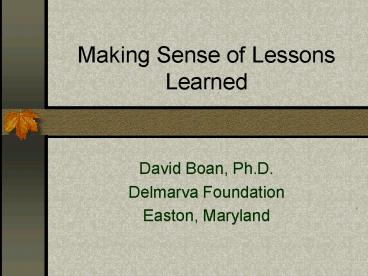Making Sense of Lessons Learned - PowerPoint PPT Presentation
1 / 16
Title:
Making Sense of Lessons Learned
Description:
Sensemaking is 'making sense' through discussion of how a person ... Helping people clarify their experience requires skills. The skills need to be practiced. ... – PowerPoint PPT presentation
Number of Views:49
Avg rating:3.0/5.0
Title: Making Sense of Lessons Learned
1
Making Sense of Lessons Learned
- David Boan, Ph.D.
- Delmarva Foundation
- Easton, Maryland
2
Overview
- Introduce concept of sensemaking
- Describe how to clarify lessons learned
(sensemaking) - Describe how to translate a lesson for others
- Describe the skills associated with each step
- Assist the group in developing their skills
through demonstration and facilitated practice
3
Sensemaking
- Sensemaking is making sense through discussion
of how a person filled gaps in their knowledge
and how they applied what they learned. The
purpose is to make explicit what may be implicit
and to make it possible for others to benefit
from the new knowledge.
4
The Process of Learning
- SituationsWhat you are doing or the subject of
your experience, e.g., a quality improvement
project. - Gaps Missing or incomplete knowledge that are
seen as needing bridging, translated in most
studies as "information needs" or the questions
people have as they make sense and move through a
situation. - UsesThe uses to which the individual puts newly
created sense or knowledge. How did you act on
this knowledge?
5
Knowledge from Problem Solving
6
Interviewing
- The lesson learned is at the end of a process.
In order to get a clear lesson you need to make
the process clear for the person who experienced
it. Getting lessons learned is not about
acquiring facts. - The fundamental skill for clarification is
reflection. Paraphrasing or reflecting back to a
person helps them reconstruct what they
experienced.
7
Key Point
- Focus your interview on insight and action. A
need gives rise to an insight, and from the
insight a solution is developed and tested. - It is common for people to repeatedly test
solutions through trial and error, especially if
they have limited access to expertise. The entire
process is worth clarifying and sharing
(sometimes called a story).
8
Key Point
- A lesson learned is not the same as a success.
People will filter what they share when they
think it not only has to be a success, but has to
be a noteworthy success to be worth sharing. - Learning is independent of success.
9
Interview Questions
- What was observed, i.e.what was the problem or
gap? - How was this interpreted?
- What action followed?
- What lesson was learned from the action?
- How was this lesson applied?
10
Group or Individual?
- The basic unit for sensemaking is the individual.
- Clarification is a social process and can be done
in groups where trust has been established. - Groups or teams are integral to sharing the
lesson beyond the individual, a process called
translation.
11
Sharing the Lesson
- Once a lesson has been clarified it must be
considered again to prepare to share with others.
Two questions - How do we know this is worth sharing?
- How do we maximize a lessons value for others?
12
Three Value Tests
- Provides an insight to help people see what will
help them with problems they face. - It is generalizable, i.e. applies to other
situations. - It is relevant, i.e. it pertains to current and
real issues faced by people.
13
A Useful Lesson
- Addresses a barrier, problem, or characteristic
that exists in the population or setting at
large, not primarily in a local population. - The action can be replicated by others and is not
based on something unique to that setting or
time, i.e. not a unique one-time event or
specific to a local setting. - The skills to implement the lesson learned are
generally available in the target population or
can be readily obtained. - The lesson learned is actionable, i.e. it
describes what a person should do in clear,
unambiguous language. It is readily
understandable.
14
Insight and Action
- When communicating with others, they will at
least need to know the insight and the action, so
they can judge - Does this give me an insight I can use?
- Is it relevant?
- Is this something I can do?
- Examples.
15
Guided Practice
- Helping people clarify their experience requires
skills. The skills need to be practiced. - Be clear about the skills. If your interview
skills are weak get a counseling handbook or
arrange for mentoring. - Practice where you can be observed and get
feedback. The importance of this cannot be
overstated.
16
Further Reading
- Dixon, Nancy (2000) Common Knowledge How
Companies Thrive by Sharing What They Know
Boston Harvard Business School Press - Weick, Karl (1995) Sensemaking in Organizations
Thousand Oaks Sage Publications - Weick, Karl and Sutcliffe, Kathleen (2001)
Managing the Unexpected Assuring High
Performance in an Age of Complexity San
Francisco Josey Bass































